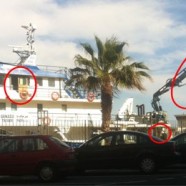Good news for seabirds
Update of “Today, when you eat tuna, you’re killing an albatross“.
The recommendation on the reducing incidental by-catch of seabirds in long-line fisheries (1) presented by the European Union, Brazil, Uruguay, South Africa and the United Kingdom (on behalf of overseas territories) was unanimously accepted this morning. The recommendation should be confirmed in plenary tomorrow.
The proposal recommends that at least two out of three mitigation measures (1- night setting 2- Bird-scaring lines /tori lines to deter birds from approaching the branch line 3- line weighting) should be applied in the area south of 25° South latitude to reduce seabird by-catches no latter than July 2013, as China had requested more time therefore a further delay of 6 months was accorded. Originally Japan wished that these techniques only be applied to certain “hot spots” which had been identified as problematic.
Today, when you eat tuna, you’re killing an albatross.
Seabirds are victims of oil spills and other pollution. Plastic waste and ghost nets drifting in oceans are also threats along with invasive rodents on the shoreline. They are also victims of tuna fishing.
Urgent mitigation measures need to be taken by ICCAT to reduce by-catch of seabird populations such as albatrosses and petrels in tuna and tuna like species long-line fisheries. Recent worldwide estimates of seabird by-catch by long-line fisheries range between 160,000 and up to 320,000 each year of which a large proportion are albatrosses and petrels. It is estimated that the Japanese tuna fleet kills over 20,000 seabirds per year which seriously impacts albatross populations. According to a document presented to the Scientific Committee it is estimated that around 10,000 seabirds are victims of incidental catch every year within ICCAT’s zone of competence. Albatrosses are surface feeders and wait for the fishermen to throw out the fishing gear. Whereas petrels, such as white-chinned petrels (Procellaria aequinoctialis), plunge into the water depths to steal the bait, they become hooked, dragged along and eventually drown.
Today, when you eat tuna, you’re killing an albatross.
Seabirds are victims of oil spills and other pollution. Plastic waste and ghost nets drifting in oceans are also threats along with invasive rodents on the shoreline. They are also victims of tuna fishing.
Urgent mitigation measures need to be taken by ICCAT to reduce by-catch of seabird populations such as albatrosses and petrels in tuna and tuna like species long-line fisheries. Recent worldwide estimates of seabird by-catch by long-line fisheries range between 160,000 and up to 320,000 each year of which a large proportion are albatrosses and petrels. It is estimated that the Japanese tuna fleet kills over 20,000 seabirds per year which seriously impacts albatross populations. According to a document presented to the Scientific Committee it is estimated that around 10,000 seabirds are victims of incidental catch every year within ICCAT’s zone of competence. Albatrosses are surface feeders and wait for the fishermen to throw out the fishing gear. Whereas petrels, such as white-chinned petrels (Procellaria aequinoctialis), plunge into the water depths to steal the bait, they become hooked, dragged along and eventually drown.
Will the “Arab Spring” be beneficial for Bluefin Tuna?
The 22nd regular meeting of the ICCAT is part of the Mediterranean Basin progressive political framework that focuses on the fishing of Bluefin Tuna. A number of NATO and military ships from ICCAT member states, in particular France and Italy, were busy around Libyan water and the Gulf of Syrte. Tuna fishing boats and their escorts have been sending Vessel Monitoring System (VMS) signals from this area prohibited from Bluefin fishing with a peak of activity in May and June.










